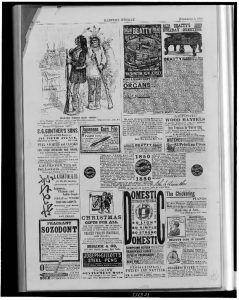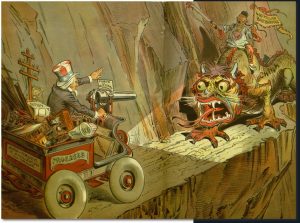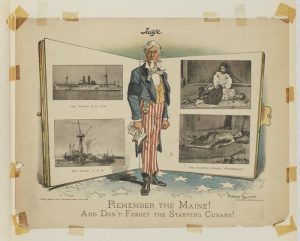Thomas Nest, “Making white men ‘good’.” Harper’s weekly, December 6,1879, p. 964.

By September of 1879, a group of around ten American government employees of the White River Indian Agency was killed by the Ute Indians [1]. This event was later known as the Meeker massacre or the White River massacre. Less than three months after the event, the wood-engraved cartoon shown above was published by Harper’s weekly, a political magazine stationed in New York, on December 6th of 1879. The cartoon was titled “Making white men ‘good'”, having three intentionally “barbaric” looking Native Americans armed with guns at the right-hand side of the picture lecturing to two White Americans at the left–one of them appears to be a depiction of Uncle Sam–about how “white men” are bad, how the native Americans never heard about the White River massacre and proceeded to make a faint threat of he knows how to make “pale face ‘good’ too”. The purpose of this cartoon is to depict Native Americans as inhumane, barbaric beings who are also untruthful and lies about the horrible atrocities they’ve committed. It is, essentially, a piece highlighting the moral difference between the Native Americans and the Protestant White Americans. This supposed moral difference between White and Native Americans is one of the fundamental moral justifications that fueled the American westward expansion during the 1800s. Following the logic of this cartoon, it is because the Native Americans are such uncivilized people, that it would be the duty of the “exceptional” Americans to bring civilization, prosperity and basic manner into them by integrating the Native Americans into the American society, thus making them “American”.
Victor Gillam, “Some One Must Back Up.” The Judge, December 8, 1900

This cartoon is the work of Victor Gillam, an American political cartoonist who worked for weekly satire magazine the Judge for 20 years. In this cartoon published by the Judge in the year 1900, Uncle Sam–the symbol of America–had a face-on confrontation with a monstrous-looking dragon–the symbol of China. Along with Uncle Sam is an early model car labeled “progress” that carries a whole bunch of American industrial products and a book titled “education”, there’s also a small canon mounted on the car whose label reads “force of necessity”. In stark contrast, the Chinese dragon who confronts Uncle Sam is ridden by an obscenely depicted Chinese man who’s apparently a Chinese boxer–a common symbolism for uncivilized Chinese–holding a blood-soaked knife and a flag saying “400 million barbarians”. This cartoon is one of many of its kind which supports America’s early colonial expansions through utilizing the concept of “American exceptionalism”. It emphasized both the moral and realistic “exceptionalism” of America: instead of waving a blood-soaked knife, Uncle Sam only use “force of necessity”, instead of bringing destruction by the force of “400 million barbarians”, Uncle Sam brings civilization and, ultimately, the American sense of freedom.
Victor Gillam, “Remember the Maine! And Don’t Forget the Starving Cubans!”The Judge, May 7, 1898, volume 34, page 312

Another cartoon by American cartoonist Victor Gillam, published in the Judge magazine of the year 1898, the year of the Spanish-American War. “Remember the Maine!” was a popular slogan prompting the US to go to war with the Spanish Empire over the alleged sabotage of the USS Maine in Havana. This political cartoon further expanded the blame towards Spain, now including the ill-treatment of Cubans under the rule of Spain. With Uncle Sam standing in the middle of the picture angrily staring into the reader, photos of the USS Maine and starving Cuban children are displayed behind him. This direct comparison between the US and the Spanish Empire’s moral standards is a more classical utilization of “American exceptionalism”. Instead of outlining the “exceptionalism” of the US by comparing to “uncivilized barbaric” such as the Native Americans or the Chinese, this primary source compared the US with the Spanish Empire who’s much more “civilized”. This is a far cry to the earliest days of the establishment of the American colonies, where European Protestants ventured to North America and aspire to establish their country as “city upon a hill” which exceeds those of the old Europeans.
Notes:
-
“The Meeker Incident, 1879,” Colorado Encyclopedia, Accessed 18 December 2019, https://coloradoencyclopedia.org/image/meeker-incident-1879
